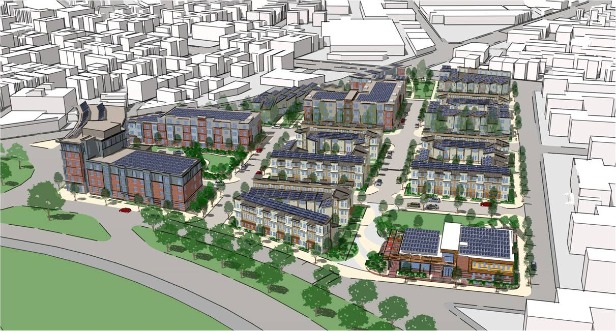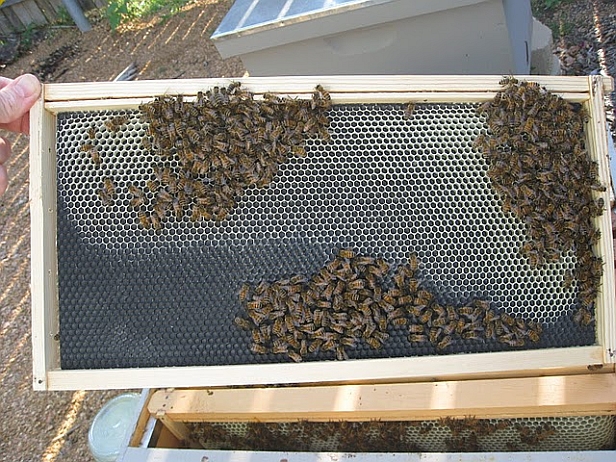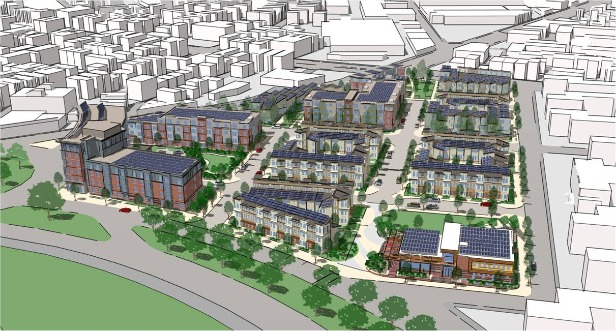 This redevelopment in South Boston’s Old Colony is going to emphasize walkable streets, open spaces, and on-site renewable energy generation.Photo: Boston Redevelopment Authority
This redevelopment in South Boston’s Old Colony is going to emphasize walkable streets, open spaces, and on-site renewable energy generation.Photo: Boston Redevelopment Authority
Cross-posted from the Natural Resources Defense Council.
Earlier this month the U.S. Green Building Council (USGBC) and Bank of America announced [PDF] ten inaugural grantees of the Affordable Green Neighborhoods program, which provides $25,000 in cash plus educational resources to help each project pursue Leadership in Energy and Environmental Design for Neighborhood Development (LEED-ND) certification. (NRDC was a founding partner in LEED-ND along with USGBC and the Congress for the New Urbanism.)
To qualify, each affordable housing grant applicant had to demonstrate efforts to strengthen surrounding neighborhoods, a commitment to engage stakeholders in the development process, and the provision of green housing for a range of income levels. Grant winners were selected from a pool of applicants by a jury of affordable housing and smart growth experts.
Funding for Affordable Green Neighborhoods is part of a broader two-year grant being provided by the Bank of America Charitable Foundation to USGBC, which administers LEED-ND. The $500,000 grant also provides educational resources and training to school districts to assist certification under LEED for Existing Buildings for Schools, which rewards schools that retrofit their facilities to green standards.
The Affordable Green Neighborhoods grant recipients represent a diversity of project types and locations across the country:
- 9th and Berks Streets Transit-Oriented Development, Philadelphia, Penn.
- Church Lane Gardens, St Louis, Mo.
- Clackamas Heights Redevelopment, Oregon City, Ore.
- Jordan Downs, Los Angeles, Calif.
- Lamar Station transit-oriented development, Lakewood, Colo.
- Old Colony Redevelopment, Boston, Mass.
- Sunnydale Hope SF [PDF], San Francisco, Calif.
- The Village at Market Creek, San Diego, Calif.
- Veterans Place at The Lancaster Corridor, Dallas, Texas
- Wyandanch Rising, Wyandanch, N.Y.
These awardees include needed revitalization efforts located in some badly distressed areas. For example, according to the Boston Housing Authority (BHA), South Boston’s Old Colony development is the most physically distressed site in the agency’s federally assisted housing portfolio. Built in 1940, the project’s building systems and infrastructure are now seriously aged, with low-income residents currently facing an annual energy and water cost of over $4,000 per unit. The site is also one of BHA’s largest, comprising 873 apartments in 22 three-story, brick walk-up buildings, on more than 16 acres. But the location is excellent for redevelopment, within walking distance of a variety of shops, services, and recreation opportunities, along with bus lines and a free shuttle to the nearby Red Line rail transit system.
There is a city library branch on the property. With the assistance of a federal stimulus grant, BHA has initiated a public-private partnership to begin a long term transformation of the site. Phase one includes some 150 new units of housing in a variety of housing types, along with a new community center. The recently approved phase two will include up to 170 more housing units, including a mix of four-story elevator buildings and clusters of three-story townhomes. The site design optimizes walkable streets, open spaces and green stormwater infrastructure.
A major emphasis of the Old Colony redevelopment will be the inclusion of energy efficiency measures, with the goal of eventually providing on-site renewable energy generation sufficient to offset all of the project’s building energy consumption. The Community Center, as the focal point for neighborhood gatherings and programs, will showcase the green elements of the project’s structure and systems, with additional visual, educational displays about sustainability and conservation. Resident self-sufficiency services will be provided for job connection and training, education, and wellness.
In the Watts district of Los Angeles, the Jordan Downs housing project was the scene of race riots in the 1960s, and later became “notorious” for being home to the city’s “Crips” street gang. The city is turning the site into a mixed-income, mixed-use, walkable neighborhood that will include a model, cutting-edge campus for the neighborhood’s Jordan High School.
Clackamas Heights is the oldest public housing property in the state of Oregon and currently provides housing for 222 residents, including 95 children. Current units have reached the end of their useful life. The buildings lack foundations, have severe structural deficiencies, and cannot meet ADA compliance. The city hired one of the country’s best sustainable architecture firms, Seattle’s Mithun, to reconceive the project.
The new concept proposes 283 units that will utilize land more efficiently through an improved site design that will connect residents with the surrounding community, providing better access to services and activities. It also provides enhanced amenities for both residents of the Heights and the surrounding neighborhood. “The Affordable Green Neighborhoods grant will provide the financial support to successfully complete the Clackamas Heights Redevelopment in a highly green and sustainable manner,” said Mary Bradshaw, project manager for the Clackamas Heights Redevelopment Housing Authority, in a press release [PDF].
No aspect of smart growth appeals to me more than inclusive, sustainable revitalization of distressed neighborhoods. These projects will now be designed to LEED-ND standards, and major props are due to the Bank of America and USGBC for helping them offset the significant costs that can be associated with LEED-ND registration and documentation. To learn more about the Affordable Green Neighborhoods Grant Program, go here.




